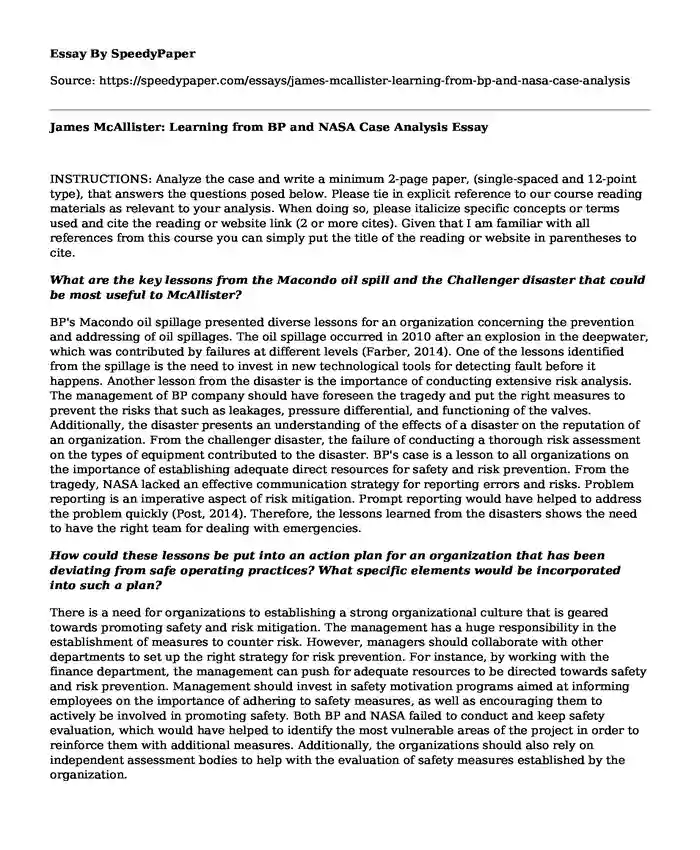
| Type of paper: | Case study |
| Categories: | Company Technology Disaster |
| Pages: | 3 |
| Wordcount: | 751 words |
INSTRUCTIONS: Analyze the case and write a minimum 2-page paper, (single-spaced and 12-point type), that answers the questions posed below. Please tie in explicit reference to our course reading materials as relevant to your analysis. When doing so, please italicize specific concepts or terms used and cite the reading or website link (2 or more cites). Given that I am familiar with all references from this course you can simply put the title of the reading or website in parentheses to cite.
What are the key lessons from the Macondo oil spill and the Challenger disaster that could be most useful to McAllister?
BP's Macondo oil spillage presented diverse lessons for an organization concerning the prevention and addressing of oil spillages. The oil spillage occurred in 2010 after an explosion in the deepwater, which was contributed by failures at different levels (Farber, 2014). One of the lessons identified from the spillage is the need to invest in new technological tools for detecting fault before it happens. Another lesson from the disaster is the importance of conducting extensive risk analysis. The management of BP company should have foreseen the tragedy and put the right measures to prevent the risks that such as leakages, pressure differential, and functioning of the valves. Additionally, the disaster presents an understanding of the effects of a disaster on the reputation of an organization. From the challenger disaster, the failure of conducting a thorough risk assessment on the types of equipment contributed to the disaster. BP's case is a lesson to all organizations on the importance of establishing adequate direct resources for safety and risk prevention. From the tragedy, NASA lacked an effective communication strategy for reporting errors and risks. Problem reporting is an imperative aspect of risk mitigation. Prompt reporting would have helped to address the problem quickly (Post, 2014). Therefore, the lessons learned from the disasters shows the need to have the right team for dealing with emergencies.
How could these lessons be put into an action plan for an organization that has been deviating from safe operating practices? What specific elements would be incorporated into such a plan?
There is a need for organizations to establishing a strong organizational culture that is geared towards promoting safety and risk mitigation. The management has a huge responsibility in the establishment of measures to counter risk. However, managers should collaborate with other departments to set up the right strategy for risk prevention. For instance, by working with the finance department, the management can push for adequate resources to be directed towards safety and risk prevention. Management should invest in safety motivation programs aimed at informing employees on the importance of adhering to safety measures, as well as encouraging them to actively be involved in promoting safety. Both BP and NASA failed to conduct and keep safety evaluation, which would have helped to identify the most vulnerable areas of the project in order to reinforce them with additional measures. Additionally, the organizations should also rely on independent assessment bodies to help with the evaluation of safety measures established by the organization.
Both BP and NASA experienced other safety tragedies (e.g., the Texas City oil refinery explosion and the Columbia disaster). Investigations pointed to similar organizational causes. What is it about organizations that allow such incidents to repeat?
Disasters are bound to repeat because of organizations' failure to establish the right countermeasures. Firstly, such incidents repeat because of a lack of organization of commitment spearheaded by the management for promoting safe. With commitment, the management can be motivated to establish a team for promoting safety. Additionally, management can ensure that there is a culture of safety. Organizations fail to realize that collective and continuous assessment of the safety measures is critical for enhancing the overall safety of a project. In this regard, safety and risk assessment is only left to a few people in the organization, creating loopholes in risk management. According to Farber (2014), managers should ratify policies for guiding employees on the safety measures and combine them with tasks, duties, and responsibilities for the parties. Organizations plunge into a similar disaster for failure to making safety and risk management a part of the overall operation approach of the company.
References
Farber, D. A. (2014). Lessons from the BP Oil Spill. Revista de Estudos Constitucionais, Hermenêutica e Teoria do Direito (RECHTD), 6(3), 232-245.
Post, S. L. (2014, June). Space shuttle case studies: Challenger and Columbia. In 121st ASEE annual conference & exposition. Retrieved from http://www.academia.edu/download/35501300/2013-Paper-ASEE-Shuttle.pdf
Cite this page
James McAllister: Learning from BP and NASA Case Analysis. (2023, Dec 29). Retrieved from https://speedypaper.com/essays/james-mcallister-learning-from-bp-and-nasa-case-analysis
Request Removal
If you are the original author of this essay and no longer wish to have it published on the SpeedyPaper website, please click below to request its removal:
- Free Essay Example on ERP History
- Samsung Vs Apple - Compare and Contrast Essay Example
- Free Research Paper Sample on Human Marine Activities
- IT Strategy for Thinking Cap, Essay Sample for Students
- Essay Example: Computer Essentials
- Free Paper Example on Cost-Reduction Methods at Amazon
- Free Essay - Technology on Artificial Intelligence
Popular categories




